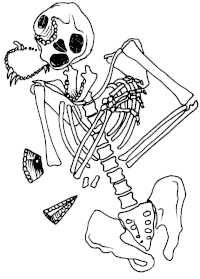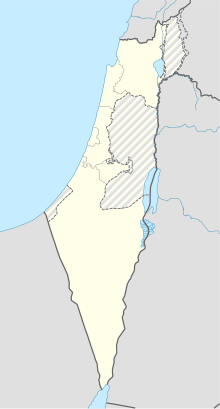| Revision as of 05:52, 4 September 2016 editGreyshark09 (talk | contribs)Extended confirmed users, Pending changes reviewers42,564 edits →External links← Previous edit |
Latest revision as of 14:40, 18 October 2024 edit undo89.153.3.107 (talk) Undid revision 1251679965 by Birdy11021954 (talk) Why is this here?Tag: Undo |
| (46 intermediate revisions by 25 users not shown) |
| Line 1: |
Line 1: |
|
|
{{Short description|Cave in Israel}} |
|
{{Infobox cave |
|
{{Infobox cave |
|
| name = Kebara Cave |
|
| name = Kebara Cave |
|
| photo = Image:Neanderthal-burial.gif |
|
| photo = Image:Neanderthal-burial.gif |
|
| photo_width = 200px |
|
| photo_width = 200px |
|
| photo_caption = Neanderthal Burial of Kebara |
|
| photo_caption = ] in situ |
|
| map = Israel |
|
| map = Near East#Israel |
|
| map_width = |
|
| map_width = |
|
| map_caption = |
|
| map_caption = |
|
| map_alt = |
|
| map_alt = |
|
| location = ], ] |
|
| location = ], ] |
|
|
| coordinates = {{coord|32|33|29.8|N|34|56|14.3|E|format=dms|display=inline,title}} |
|
| lat_d = 32 | lat_m = 33 |lat_s = 29.8 | lat_NS = N |
|
|
|
| depth = |
|
| long_d = 34 | long_m = 56 | long_s = 14.3 | long_EW = E |
|
|
| depth = |
|
| length = |
|
| length = |
|
|
| height_variation = |
|
| height_variation = |
|
| altitude = {{convert|60|m|ft}} above sea level |
|
| elevation = {{convert|60|to|65|m|ft|abbr=on}} above sea level |
|
| discovery = Early 1930s |
|
| discovery = Early 1930s |
|
| geology = Limestone |
|
| geology = Limestone |
|
| entrance_count = |
|
| entrance_count = |
|
| entrance_list = |
|
| entrance_list = |
|
| difficulty = |
|
| difficulty = |
|
| hazards = |
|
| hazards = |
|
| access = |
|
| access = |
|
| show_cave = |
|
| show_cave = |
|
| show_cave_length = |
|
| show_cave_length = |
|
| lighting = |
|
| lighting = |
|
| visitors = |
|
| visitors = |
|
| features = |
|
| features = |
|
| survey = |
|
| survey = |
|
| survey_format = |
|
| survey_format = |
|
| website = |
|
| website = |
|
}} |
|
}} |
| ⚫ |
'''Kebara Cave''' (]: מערת כבארה ''Me'arat Kebbara'', ]: مغارة الكبارة ''Mugharat al-Kabara'') is an ]i ] ] locality of the ], situated at 60 - 65 metres ] on the western ] of the ], in the ] preserve of ].<ref></ref> The cave was inhabited between 60,000 - 48,000 ] and is famous for its ] finds of ] remains, made under the direction of Professor ]. |
|
|
|
|
|
|
⚫ |
'''Kebara Cave''' ({{langx|he|מערת כבארה|Me'arat Kebbara}}, {{langx|ar|مغارة الكبارة|Mugharat al-Kabara}}) is a ] ] locality in Wadi Kebara, situated at {{convert|60|to|65|m|ft|abbr=on}} ] on the western ] of the ], in the ] preserve of ].<ref>{{Cite web |url=http://www.ramat-hanadiv.org.il/sites/default/files/media/general_page/field_gp_related_files/Nature%20Park%20Map.pdf |title=map |access-date=2013-10-11 |archive-url=https://web.archive.org/web/20131010233100/http://www.ramat-hanadiv.org.il/sites/default/files/media/general_page/field_gp_related_files/Nature%20Park%20Map.pdf |archive-date=2013-10-10 |url-status=dead }}</ref> |
| ⚫ |
] and ] excavated in the cave in the early 1930s, but by far the most significant discovery made at Kebara Cave was that in 1982 of the most complete ] ] found to date. Nicknamed "Moshe" and dating to ''circa'' 60,000 ], the skeleton preserved a large part of one individual's torso (], ]s and ]). The ] and most of the lower limbs were missing. The ] was also preserved, and was the first Neanderthal hyoid bone found.<ref name="mithen">](2006). The Singing Neanderthals: The origins of music, language, mind, and body. Cambridge, MA: Harvard University Press.</ref> |
|
|
|
|
|
|
|
==History== |
| ⚫ |
The ] culture is named after the site. |
|
|
|
The cave was inhabited between 60,000 and 48,000 ] and is famous for its ] finds of ] remains. |
|
|
|
|
|
] and ] excavated in the cave in the early 1930s. Excavations have since yielded a large number of human remains associated with a ] archaeological context. The first specimen discovered in 1965, during the excavations of M. Stekelis, was an incomplete infant skeleton (Kebara 1).<ref></ref> |
|
|
|
|
⚫ |
The most significant discovery made at Kebara Cave was ] in 1982, the most complete postcranial ] ] found to date. Nicknamed "Moshe" and dating to ''circa'' 60,000 ], the skeleton preserved a large part of one individual's torso (], ]s and ]). The ] and most of the lower limbs were missing. The ] was also preserved, and was the first Neanderthal hyoid bone found.<ref name="mithen">](2006). The Singing Neanderthals: The origins of music, language, mind, and body. Cambridge, Massachusetts: Harvard University Press.</ref> |
|
|
|
|
⚫ |
The ] is named after the site. |
|
|
|
|
|
== See also == |
|
== See also == |
|
* ] |
|
* ] |
|
* ] ''(with link directory)'' |
|
* ] ''(with link directory)'' |
|
* ] |
|
* ] |
| ⚫ |
* ] |
|
|
* ] |
|
* ] |
|
⚫ |
* ] |
|
|
|
| ⚫ |
==Further reading== |
|
|
|
|
|
Selected bibliography, in order of publication: |
|
|
|
|
| ⚫ |
*Schick, T. & Stekelis, M. "Mousterian Assemblages in Kebara Cave, Mount Carmel", ''Eretz-Israel'' 13 (1977), pp.97-150. |
|
| ⚫ |
*Bar-Yosef, O. & B. Vandermeersch, ''et alii'', "The Excavations in Kebara Cave, Mount Carmel", '']'' 33.5 (1992), pp.497-546. |
|
| ⚫ |
*Goldberg, P. & Bar-Yosef, O., "Site formation processes in Kebara and Hayonim Caves and their significance in Levantine Prehistoric caves", in T. Akazawa, K. Aoki and O. Bar-Yosef (eds), ''Neandertals and Modern Humans in Western Asia'', New York & London: Plenum Press, 1998, pp.? |
|
| ⚫ |
*Albert, Rosa M., Steve Weiner, Ofer Bar-Yosef, and Liliane Meignen, "Phytoliths of the Middle Palaeolithic Deposits of Kebara Cave, Mt. Carmel, Israel: Study of the Plant Materials Used for Fuel and Other Purposes", '']'' 27 (2000), pp.931-947. |
|
| ⚫ |
*Lev, Efraim, Kislev, Mordechai E. & Bar-Yosef, Ofer, "Mousterian Vegetal Food in Kebara Cave, Mt Carmel", '']'' 32 (2005), pp.475–484. |
|
|
|
|
|
|
==References== |
|
==References== |
|
{{Reflist}} |
|
{{Reflist}} |
|
|
|
|
⚫ |
==Further reading== |
|
⚫ |
* Schick, T. & Stekelis, M. "Mousterian Assemblages in Kebara Cave, Mount Carmel", ''Eretz-Israel'' 13 (1977), pp. 97–150. |
|
⚫ |
* Bar-Yosef, O. & B. Vandermeersch, ''et alii'', "The Excavations in Kebara Cave, Mount Carmel", '']'' 33.5 (1992), pp. 497–546. |
|
⚫ |
* Goldberg, P. & Bar-Yosef, O., "Site formation processes in Kebara and Hayonim Caves and their significance in Levantine Prehistoric caves", in T. Akazawa, K. Aoki and O. Bar-Yosef (eds), ''Neandertals and Modern Humans in Western Asia'', New York & London: Plenum Press, 1998, pp.? |
|
⚫ |
* Albert, Rosa M., Steve Weiner, Ofer Bar-Yosef, and Liliane Meignen, "Phytoliths of the Middle Palaeolithic Deposits of Kebara Cave, Mt. Carmel, Israel: Study of the Plant Materials Used for Fuel and Other Purposes", '']'' 27 (2000), pp. 931–947. |
|
⚫ |
* Lev, Efraim, Kislev, Mordechai E. & Bar-Yosef, Ofer, "Mousterian Vegetal Food in Kebara Cave, Mt Carmel", '']'' 32 (2005), pp. 475–484. |
|
|
|
|
|
==External links== |
|
==External links== |
|
|
{{Commons category}} |
|
* - the Rothschild Memorial public gardens at ] preserve the Kebara Cave within their boundaries for visitors |
|
* {{Webarchive|url=https://web.archive.org/web/20110716080625/http://www.ramat-hanadiv.org.il/index_en.aspx |date=2011-07-16 }} - the Rothschild Memorial public gardens at ] preserve the Kebara Cave within their boundaries for visitors |
|
* at About.com |
|
|
|
* {{Webarchive|url=https://web.archive.org/web/20050922073231/http://archaeology.about.com/library/glossary/bldef_kebara.htm |date=2005-09-22 }} at About.com |
| ⚫ |
{{DEFAULTSORT:Kebara}} |
|
|
|
|
|
|
{{Epipalaeolithic Southwest Asia}} |
|
{{Navbox prehistoric caves}} |
|
{{Navbox prehistoric caves}} |
|
{{Caves in Israel}} |
|
{{Caves in Israel}} |
|
|
{{Homo neanderthalensis|state=expanded}} |
|
|
{{Authority control}} |
|
|
|
|
|
⚫ |
{{DEFAULTSORT:Kebara}} |
|
|
] |
|
] |
|
] |
|
] |
|
|
] |
|
] |
|
] |
|
] |
|
|
] |
|
|
|
|
|
] |
|
{{Israel-archaeology-stub}} |
|
|
|
] |
|
{{Israel-geo-stub}} |
|
|
|
] |
 Kebara 2 in situ
Kebara 2 in situ
